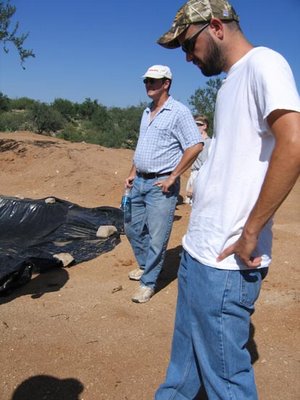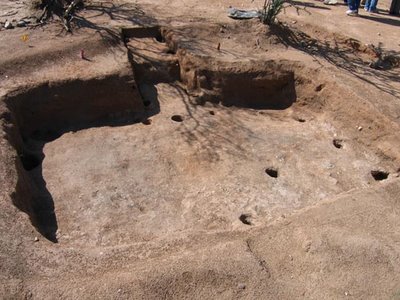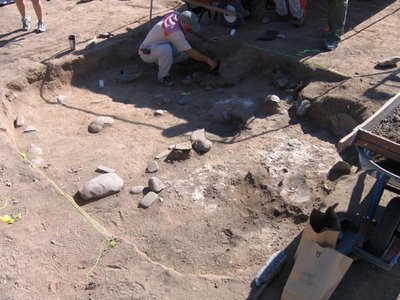Wednesday, September 06, 2006
Unlike yesterday, I did not step in cat diarrhea when I got up. Luckily for me, Puff is feeling much, much better.
My company is doing a major dig north of Tucson and today was the staff tour. I called up Chris and Forrest and invited them to come along with me.

Chris and Forrest.
The middle of the site, where the densest archaeological features are, is being preserved. The outlying areas will soon be bulldozed for condos. So far over 200 prehistoric pit structures, where people once lived and worked, have been found. Because there are so many, we can't even dig all of them.

Hohokam pit structure, circa A.D. 1000.
If you are a long-time reader you can skip the next bit, where I explain what a pit structure is. The Hohokam (and other prehistoric Native Americans in the Southwest) dug shallow pits for the foundations of their homes. The shape of the pits changed through time- from round, to subrectangular, to rectangular. A ramped or stepped entrance way usually stuck off one side, with a small, plastered fire hearth just inside the house. A number of postholes once held posts to support the roof and walls. Plaster, made from ground caliche (a limestone hardpan layer that develops in this area) was often smeared onto the floor and walls. The outer walls and roof were made from bundles of grass and reeds, with mud plaster coating the exterior.
Sometimes you find storage pits in the floors where the people stored food or unused tools. Storage houses, with very large pits, were present in pre-Hohokam days. After the development of pottery, these storage houses disappeared.
About 70 percent of Hohokam houses found are burnt, sometimes with the possessions of the people still inside. It is thought that houses were burnt by accident (by grassfires or when hearths sparked and caught interiors on fire) or on purpose, perhaps when someone died.

House with artifacts lying on the floor.
This house had burnt and had a number of pots, including one unbroken scoop, along with many manos (grinding stones) lying on its floor.
It is somewhat depressing knowing that the areas we were walking over will soon be the homes for rich people moving here from other places, most of whom could care less about this region's history. On the other hand, our excavations will have recovered a lot of information and artifacts that will be used to write the history of this prehistoric community.
Newer› ‹Older
My company is doing a major dig north of Tucson and today was the staff tour. I called up Chris and Forrest and invited them to come along with me.

Chris and Forrest.
The middle of the site, where the densest archaeological features are, is being preserved. The outlying areas will soon be bulldozed for condos. So far over 200 prehistoric pit structures, where people once lived and worked, have been found. Because there are so many, we can't even dig all of them.

Hohokam pit structure, circa A.D. 1000.
If you are a long-time reader you can skip the next bit, where I explain what a pit structure is. The Hohokam (and other prehistoric Native Americans in the Southwest) dug shallow pits for the foundations of their homes. The shape of the pits changed through time- from round, to subrectangular, to rectangular. A ramped or stepped entrance way usually stuck off one side, with a small, plastered fire hearth just inside the house. A number of postholes once held posts to support the roof and walls. Plaster, made from ground caliche (a limestone hardpan layer that develops in this area) was often smeared onto the floor and walls. The outer walls and roof were made from bundles of grass and reeds, with mud plaster coating the exterior.
Sometimes you find storage pits in the floors where the people stored food or unused tools. Storage houses, with very large pits, were present in pre-Hohokam days. After the development of pottery, these storage houses disappeared.
About 70 percent of Hohokam houses found are burnt, sometimes with the possessions of the people still inside. It is thought that houses were burnt by accident (by grassfires or when hearths sparked and caught interiors on fire) or on purpose, perhaps when someone died.

House with artifacts lying on the floor.
This house had burnt and had a number of pots, including one unbroken scoop, along with many manos (grinding stones) lying on its floor.
It is somewhat depressing knowing that the areas we were walking over will soon be the homes for rich people moving here from other places, most of whom could care less about this region's history. On the other hand, our excavations will have recovered a lot of information and artifacts that will be used to write the history of this prehistoric community.
